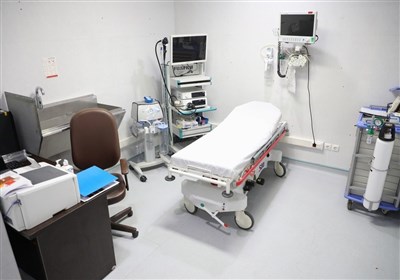
View of an Iranian medical examination room in July 2023.
“The quality of Iran’s medical education … has led to the discussion of increasing medical tourism in the country.”
Iran is facing a hard currency crunch. The excerpted article from Iranian Students’ News Agency focuses on the Iranian government’s desire to promote medical tourism to raise new hard currency.[i]. Over the past year alone, the Iranian government says the industry has netted $1 billion for the Iranian economy. On 3 July 2023, Mahdi Safari, Deputy Foreign Minister for Economic Diplomacy, said the Foreign Ministry hoped to attract 6 million medical tourists to Iran annually. Health Minister Bahram Einollahi said Iran expected 240 hospitals to accept medical tourists. The lack of international accreditation for Iranian hospitals, however, puts Iran at a disadvantage in comparison to Turkey and India, its two nearest competitors in the field. Nevertheless, as the regime looks for more hard currency, it seeks to overcome such challenges. On 22 July 2023, for example, Einollahi, Foreign Minister Hossein Amir Abdollahian, and Cultural Heritage, Tourism, and Handicrafts Minister Ezzatollah Zarghami gathered to discuss the industry jointly in a roundtable with parliamentarians. Advertisements by medical tourism companies promise not only visa services, but also interpreters and hotel bookings, all of which require coordination between ministries. There are also security and military aspects to the development of the medical tourism industry. First, while Iran’s foreign ministry officially issues visas, the intelligence ministry must approve visa applications. Although Iranian medical tourism companies claim that the foreign ministry will allow Americans, British, and Canadians to purchase medical tourism packages, it is unclear the extent to which Iranian security services will view this as a backdoor for Iranian adversaries to access the country. Given the long history of Iranian hostage-taking, Western tourists might become prime targets. Second, it remains unclear how the Islamic Revolutionary Guard Corps (IRGC) will address the issue. Khatam al-Anbiya, the IRGC’s economic wing, controls up to 40 percent of the Iranian economy and tends to focus its energy on industries that allow it to access hard currency.[ii] While it will be difficult for the IRGC to involve itself in medical tourism, the potential growth of the sector into a multi-billion dollar income stream means it will either find a creative way or, as money often equates to power, find a way to shut down the industry to preserve its own privileged position.
Sources:
“Kifiyat-e Amuzesh-e Pezeshki Iran Movajeb Tawseah-e Turizm Darmani Shodeh Ast” (The Quality of Medical Education in Iran has led to the Development of Medical Tourism),” Iranian Students’ News Agency (an ostensibly private news agency close to Iran’s security and intelligence apparatus), 8 July 2023. https://www.isna.ir/news/1402041710168
The deputy minister of health for education announced the call for 3,000 staff members and said, the call will be made in several stages in different regions, each according to its need. Dr. Abulfazl Bagheri Fard, in a meeting with faculty members of Hormozgan University of Medical Sciences this morning, pointed out the increase in the number of available residency slots in this year’s exam, and the improvement in their pay, he noted, in the 13th government [led by President Ebrahim Raisi], a plan was presented to the Planning and Budget to increase the salaries of medical residents so that they would receive the same salary as general practitioners… He noted, “The quality of Iran’s medical education is both a source of pride and has led to the discussion of increasing medical tourism in the country. Training should be dynamic and up-to-date, and regulations should be revised based on conditions. For example, this topic was used to increase the number of available fellowships in 2022 based on structured interviews. He mentioned the inclusion of cardiac and thoracic surgery in the residency exam, and the ability to participate in the emergency medicine and anesthesiology residency exam without submitting a [broader] plan….The Deputy Minister of Health for education referred to the review of the regulations on the promotion of faculty members based on their performance and impact in training and strengthening the position of the university, and added that the launch of the disciplines was also decided based on the needs of the country and with the advice of the board members.
Notes:
[i] While Iranian officials often blame their country’s dire financial situation on sanctions, structural problems within the Iranian economy take a greater toll. The IRGC dominates certain industries, for example, and often refuses to subject itself to basic laws and regulations. The lack of commercial law and interference by an ever-shifting array of power centers hampers foreign direct investment. For these reasons, many contracts go unfulfilled. Rampant inflation and continued subsidies for bread, electricity, and gasoline hemorrhage hard currency. The opacity of spending, especially by the IRGC, and the arbitrariness of figures published by the Central Bank increases uncertainty about Iran’s hard currency reserves at any given time.
[ii] See: Michael Rubin, “IRGC Wins Multibillion Dollar Economic Projects” OE Watch, August 2018. https://community.apan.org/wg/tradoc-g2/fmso/m/oe-watch-past-issues/241432/download
Image Information:
Image: View of an Iranian medical examination room in July 2023.
Source: https://newsmedia.tasnimnews.com/Tasnim/Uploaded/Image/1402/04/03/1402040313545118927824543.jpg
Attribution: Tasnim News Agency
